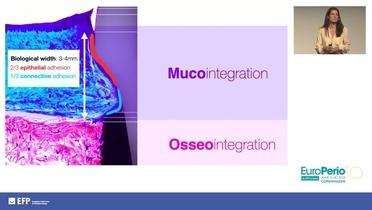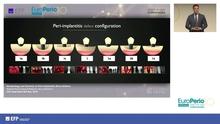New treatment concepts to prevent and manage peri-implant diseases - part 3 a new treatment approach
Video highlights
- Discuss the aim of peri-implantitis therapy
- Compare the available treatment concepts for peri-implantitis
- Explain the role of electrolytic approach in peri-implantitis treatment
How can you achieve a good long-term result when dealing with peri-implantitis therapy? This is the first question Dr. Markus Schlee addresses in his presentation on therapies for peri-implantitis. He states the goal of any therapy: a therapy should have the aim to heal. In relation to implantology, this means a bone-level implant is covered in surrounding bone up to the implant collar. Peri-implantitis therapy should thus regain bone and enable osseointegration and achieve a stable situation. The next important question addressed is, what is managed in cases of peri-implantitis? As a clinician, the focus is on an infection, caused by a biofilm, which is on the implant and in the implant.
When reviewing the literature, no clear definition can be found to define a good outcome of peri-implantitis therapy. What outcome would be considered as a success? And, what percentage of patients treated successfully would be sufficient – 10 or 70%? The treating surgeon selects one of the established surgeries or treatment modalities and needs to be able to answer this question. Dr. Schlee highlights that peri-implantitis also needs to be considered in a wider context, meaning what does an infection in the mouth cause? When looking at periodontitis, it is known that there are a lot of side effects present, such as an increased number of leukocytes and pro-inflammatory cytokines. This means that there is a systemic impact.
There is a common understanding that a current therapy requires open flap debridement and removal of granulation tissue. This is followed by decontamination of the exposed surface and then in some cases augmentation, a resective approach or a combination of approaches is needed. What happens to an implant surface that is exposed in the oral cavity? There will be an immediate colonization of bacteria. Does the implant surface have an influence on this? Is there a difference between smooth and rough implant surfaces? The literature shows that there is no significant difference related to the implant surface. However, one needs to be cautious when reviewing the clinical data as there are conflicting results.
Why are existing treatment approaches so complicated and why don't they produce the desired results? Ablative removal of the biofilm, which is a known treatment of periodontitis, does not result in a satisfactory outcome. Similarly, powder spray, brushes or currettes, do not produce an acceptable result. They reach their limit when an undercut or a crater-like bone defect making the access to all exposed implant areas even more difficult.
Experience with the existing therapy approaches and various evaluations led to the development of a new therapy, using an electrolytic approach. The electrolytic approach aims to remove the biofilm covering the implant in an easily applicable manner. The therapy works with the restoration in place or removed and with any implant system. Dr. Schlee presents the available clinical data, comparing this new therapy with the established therapies such as powder spray, or brushes. The data show highly promising results, achieving the ultimate aim of therapy, the re-osseointegration of every treated implant.
View part one of this series here with Dr. France Lambert’s introduction to the topic and Dr. Giacomo Fabbri’s discussion on the prosthetic aspects of prevention of peri-implant disease. In part two, Dr. Alberto Monje reviews the surgical therapy options.
References
[1] Roccuzzo M, Layton DM, Roccuzzo A, Heitz-Mayfield LJ. Clinical outcomes of peri-implantitis treatment and supportive care: A systematic review. Clin Oral Implants Res. 2018 Oct;29 Suppl 16:331-350. doi: 10.1111/clr.13287. PMID: 30328195.
[2] Heitz-Mayfield LJ, Mombelli A. The therapy of peri-implantitis: a systematic review. Int J Oral Maxillofac Implants. 2014;29 Suppl:325-45. doi: 10.11607/jomi.2014suppl.g5.3. PMID: 24660207.
[3] Esposito M, Grusovin MG, Worthington HV. Treatment of peri-implantitis: what interventions are effective? A Cochrane systematic review. Eur J Oral Implantol. 2012;5 Suppl:S21-41. PMID: 22834392.
[4] Chaushu L, Tal H, Sculean A, Fernández-Tomé B, Chaushu G. Peri-implant disease affects systemic complete blood count values-an experimental in vivo study. Clin Oral Investig. 2020 Dec;24(12):4531-4539. doi: 10.1007/s00784-020-03318-0. Epub 2020 May 16. PMID: 32415398.
[5] Carcuac O, Berglundh T. Composition of human peri-implantitis and periodontitis lesions. J Dent Res. 2014 Nov;93(11):1083-8. doi: 10.1177/0022034514551754. Epub 2014 Sep 26. PMID: 25261052; PMCID: PMC4293768.
[6] Jeelani S, Rajkumar E, Mary GG, Khan PA, Gopal H, Roy S, Maheswaran T, Anand B. Squamous cell carcinoma and dental implants: A systematic review of case reports. J Pharm Bioallied Sci. 2015 Aug;7(Suppl 2):S378-80. doi: 10.4103/0975-7406.163457. PMID: 26538881; PMCID: PMC4606623.
[7] Heitz-Mayfield LJA, Salvi GE, Mombelli A, Faddy M, Lang NP. Anti-infective surgical therapy of peri-implantitis. A 12-month prospective clinical study. Clin Oral Implants Res. 2012 Feb;23(2):205-210. doi: 10.1111/j.1600-0501.2011.02276.x. Epub 2011 Aug 9. PMID: 22092831.
[8] Schwarz F, Schmucker A, Becker J. Efficacy of alternative or adjunctive measures to conventional treatment of peri-implant mucositis and peri-implantitis: a systematic review and meta-analysis. Int J Implant Dent. 2015 Dec;1(1):22. doi: 10.1186/s40729-015-0023-1. Epub 2015 Aug 13. PMID: 27747644; PMCID: PMC5005629.
[9] Fürst MM, Salvi GE, Lang NP, Persson GR. Bacterial colonization immediately after installation on oral titanium implants. Clin Oral Implants Res. 2007 Aug;18(4):501-8. doi: 10.1111/j.1600-0501.2007.01381.x. Epub 2007 May 15. PMID: 17501978.
[10] Zetterqvist L, Feldman S, Rotter B, Vincenzi G, Wennström JL, Chierico A, Stach RM, Kenealy JN. A prospective, multicenter, randomized-controlled 5-year study of hybrid and fully etched implants for the incidence of peri-implantitis. J Periodontol. 2010 Apr;81(4):493-501. doi: 10.1902/jop.2009.090492. PMID: 20367092.
[11] Carcuac O, Derks J, Abrahamsson I, Wennström JL, Berglundh T. Risk for recurrence of disease following surgical therapy of peri-implantitis-A prospective longitudinal study. Clin Oral Implants Res. 2020 Nov;31(11):1072-1077. doi: 10.1111/clr.13653. Epub 2020 Sep 14. PMID: 32870513.
[12] Schwarz F, John G, Becker J. The influence of implantoplasty on the diameter, chemical surface composition, and biocompatibility of titanium implants. Clin Oral Investig. 2017 Sep;21(7):2355-2361. doi: 10.1007/s00784-016-2030-x. Epub 2016 Dec 24. PMID: 28012063.
[13] Romeo E, Ghisolfi M, Murgolo N, Chiapasco M, Lops D, Vogel G. Therapy of peri-implantitis with resective surgery. A 3-year clinical trial on rough screw-shaped oral implants. Part I: clinical outcome. Clin Oral Implants Res. 2005 Feb;16(1):9-18. doi: 10.1111/j.1600-0501.2004.01084.x. PMID: 15642026.
[14] Burgueño-Barris G, Camps-Font O, Figueiredo R, Valmaseda-Castellón E. The Influence of Implantoplasty on Surface Roughness, Biofilm Formation, and Biocompatibility of Titanium Implants: A Systematic Review. Int J Oral Maxillofac Implants. 2021 September/October;36(5):e111–e119. doi: 10.11607/jomi.8785. Epub 2021 Jun 22. PMID: 34157063.
[15] Ratka C, Weigl P, Henrich D, Koch F, Schlee M, Zipprich H. The Effect of In Vitro Electrolytic Cleaning on Biofilm-Contaminated Implant Surfaces. J Clin Med. 2019 Sep 6;8(9):1397. doi: 10.3390/jcm8091397. Erratum in: J Clin Med. 2022 Feb 08;11(3): PMID: 31500093; PMCID: PMC6780638.
[16] Schlee M, Naili L, Rathe F, Brodbeck U, Zipprich H. Is Complete Re-Osseointegration of an Infected Dental Implant Possible? Histologic Results of a Dog Study: A Short Communication. J Clin Med. 2020 Jan 16;9(1):235. doi: 10.3390/jcm9010235. PMID: 31963136; PMCID: PMC7020040.
[17] Schlee M, Rathe F, Brodbeck U, Ratka C, Weigl P, Zipprich H. Treatment of Peri-implantitis-Electrolytic Cleaning Versus Mechanical and Electrolytic Cleaning-A Randomized Controlled Clinical Trial-Six-Month Results. J Clin Med. 2019 Nov 7;8(11):1909. doi: 10.3390/jcm8111909. PMID: 31703404; PMCID: PMC6912411.
[18] Schlee M, Wang HL, Stumpf T, Brodbeck U, Bosshardt D, Rathe F. Treatment of Periimplantitis with Electrolytic Cleaning versus Mechanical and Electrolytic Cleaning: 18-Month Results from a Randomized Controlled Clinical Trial. J Clin Med. 2021 Aug 6;10(16):3475. doi: 10.3390/jcm10163475. PMID: 34441770; PMCID: PMC8397046.
Clinical topics
Additional resources
Questions
Ask a questionIf “misfit joints” caused/contributed to the disease, why reinstall the offending prosthesis after cleaning the implants?
We know misfit joints are a risk factor for peri-implantitis and a common consequence of installing prostheses by the screw-in techique. After we remove the prosthesis for electrolytic cleaning, why reinstall the prosthesis that likely created the problem in the first place? Would the clinician not expect relapse of the problem?? Is this not what you are seeing?
I have identified the root causes of misfits as Prosthesis Dimensional Error, Incongruent Paths of Insertion and Resistence to Displacement by adjacent tissues. It is possible to mitigate these root problems but not by using prostheses installed by the screw-in technique. More at www.ReverseMargin.com.
We know misfit joints are a risk factor for peri-implantitis and a common consequence of installing prostheses by the screw-in techique. After we remove the prosthesis for electrolytic cleaning, why reinstall the prosthesis that likely created the problem in the first place? Would the clinician not expect relapse of the problem?? Is this not what you are seeing?
I have identified the root causes of misfits as Prosthesis Dimensional Error, Incongruent Paths of Insertion and Resistence to Displacement by adjacent tissues. It is possible to mitigate these root problems but not by using prostheses installed by the screw-in technique. More at www.ReverseMargin.com.
How can misfit joints be prevented to reduce peri-implantitis?
Dr. Schlee shows ample exudate inside an implant under its cover. Why do we not discuss the root causes of misfit joints in order to prevent this common problem? I propose Prosthesis Dimensional Error PDE), Incongrent Paths of Insertion (ICPOI) and Resistance to Displacement by Tissues (RTDE) during the Screw-in prosthesis installation process as the root causes of misfit connections. www. ReverseMargin.com. According to Heitz, Heitz and Lang 2020 misfit joints are risk factors for peri-implantitis.
Dr. Schlee shows ample exudate inside an implant under its cover. Why do we not discuss the root causes of misfit joints in order to prevent this common problem?
I propose Prosthesis Dimensional Error PDE), Incongrent Paths of Insertion (ICPOI) and Resistance to Displacement by Tissues (RTDE) during the Screw-in prosthesis installation process as the root causes of misfit connections. www. ReverseMargin.com. According to Heitz, Heitz and Lang 2020 misfit joints are risk factors for peri-implantitis.






Does this electrolysis method work on one piece implants, such as MDI ?
In reply to Does this electrolysis method work on one piece implants, such as MDI ? by valentin petrov
The device works on every metal surface. The question is what are your aims? If you go for reosseointegration then an augmentation after the cleaning is required. Submerged healing may be beneficial if you plan to augment. GalvoSurge works equally good if you just touch the outer surface of the implant compared to taking off the restoration in two piece implants.
In reply to Does this electrolysis method work on one piece implants, such as MDI ? by valentin petrov
I have used this galvosurg to eliminate longstanding peri-implantitis surrounding implants used for overdenture retention - with great success. Thank you
Misfit implat parts related to the screw-in installation system are a breeding ground for oral pathogens. What do you suggest to prevent misfits that will likely reinfect the peri-implant environment after successful reintegration has been accomplished?
What are the root causes of these misfits?